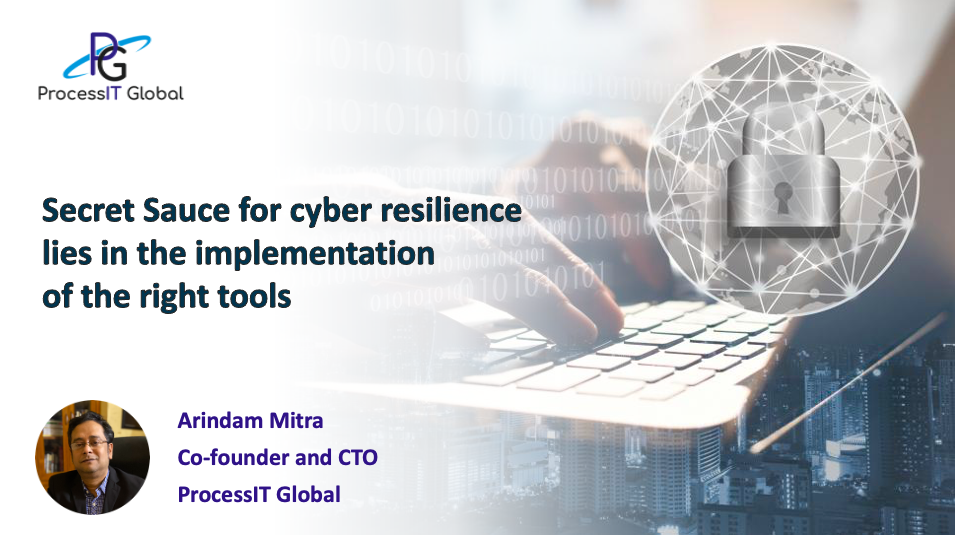Secret Sauce for cyber resilience lies in the implementation of the right tools - Arindam Mitra, Co-founder and CTO and ProcessIT Global

Business models of today are driving organizations toward
digital dependencies which unfortunately is further aggravating the cybercrime
situation. Cybercriminals can hack a computer in an MNC with the same ease as
hacking a personal computer from a remote location.They can effortlessly steal
sensitive personal and professional information causing several setbacks to
individual users and organizations. Cybersecurity incidents and data breaches
have huge cost implications and customer churn possibilities while hurting the
brand’s reputation. All these have
long-lasting economic consequences for the affected organizations. Such
unauthorized access leaves the users feeling angry
and powerless too, hampering their work efficiency. Organizations that fail to
demonstrate strong corporate governance around cybersecurity, have business
continuity challenges as well.
Common types of threats include, Malware attacks, Distributed Denial of Service (DDoS) attacks, Phishing, and Ransomware among others. It should also be acknowledged that security incidents are not always caused by external threat actors but by company insiders as well which also includes accidental data breaches. Research reveals that 95% of cybersecurity issues can be traced to human error, wherein 43% are incidental or accidental. Yes, data breaches could be due to external or internal human errors, or security issues with third-party applications and cloud storage
Improving
cybersecurity with appropriate solutions
The
traditional cybersecurity tools and methods that were practiced in the past are
not considered adequate in today’s digital age where the cyber threat landscape
is highly complex. Attackers are constantly updating their techniques and
tactics to evade security defenses deployed at organizations. Increasingly businesses
are compelled to adopt a holistic approach to cybersecurity to effectively combat
the threats.
A broad range
of cyber security solutions is designed to safeguard data, networks, and
systems.
Identity
and Access Management (IAM)
With IAM, it is much easier to monitor the usage of business data and access privileged information. The IAM systems identify, authenticate, and authorize individuals and give them access rights to the resources. The IAM framework has a database for storing IDs and access credentials in addition to tracking login and access history. Single Sign-On and Multi-Factor Authentication are some of the key IAM tools for improving access and helping in saving costs.
Artificial
Intelligence for IT Operations (AIOps)
AI and machine learning technologies with big data and automation form the AIOps that help in making IT operations smarter, the need of the hour in today’s modern complex environments. They aggregate huge volumes of operations data from multiple IT sources and intelligently identify significant patterns related to availability and performance issues. They then help to analyze the data and report to IT teams for further action. AIOps also automate responses in real time. This solution is very crucial in today’s mix of on-prem, hybrid cloud, and multi-cloud environments. Furthermore, it learns continuously to be able to solve future problems in addition to providing predictive alerts.
XDR and
NGFW
Extended Detection and Response or XDR is one of the latest entrants to the cybersecurity solutions space. It is a unified security incident detection and automated response platform. XDR also unifies visibility and control across all endpoints, the network infrastructure, and the cloud. By centralizing data from different data streams into a single repository, XDR tools provide a holistic view of potential threats. XDR leverages Endpoint Detection and Response (EDR) and next-generation network firewalls (NGFW) to integrate endpoints and networks.
SIEM,
UEBA, and SOAR
SIEM (Security
Information and Event Management) and SOAR (Security Orchestration, Automation,
and Response) solutions are leveraged to automate and orchestrate threat
detection and reduce false positives as they have threat intelligence
integrated. It helps to streamline
teams, processes, and tools while having the capabilities to further scale and
speed.
User and Entity Behaviour Analytics solutions will help in detecting insider threats, such as abnormal or risky behaviors of users.
Organizations have to take into consideration several factors and a more holistic approach as they take on the task of improving the cybersecurity posture. A certain level of preparedness is necessary to anticipate and address any incident, by adopting the relevant tools which should be included in the cybersecurity strategy making it flexible and effective.


